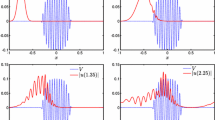Abstract
Linear integral operators describing physical problems on symmetric domains often are equivariant, which means that they commute with certain symmetries, i.e., with a group of orthogonal transformations leaving the domain invariant. Under suitable discretizations the resulting system matrices are also equivariant. A method for exploiting this equivariance in the numerical solution of linear equations and eigenvalue problems via symmetry reduction is described. A very significant reduction in the computational expense in both the assembling of the system matrix and in solving linear systems can be obtained in this way. This reduction is particularly important because the system matrices are typically full. The basic ideas underlying our method and its analysis involve group representation theory. We concentrate here on the use of symmetry adapted bases and their automated generation. In this paper symmetry reduction is studied in connection with quadrature formulae and the Nyström method. A software package has been posted on the Internet.
Similar content being viewed by others
References
E.L. Allgower, K. Böhmer, K. Georg and R. Miranda, Exploiting symmetry in boundary element methods, SIAM J. Numer. Anal. 29 (1992) 534-552.
E.L. Allgower, K. Georg and R. Miranda, Exploiting permutation symmetry with fixed points in linear equations, in: Exploiting Symmetry in Applied and Numerical Analysis, eds. E.L. Allgower, K. Georg and R. Miranda, Lectures in Applied Mathematics, Vol. 29 (American Mathematical Society, Providence, RI, 1993) pp. 23-36.
E.L. Allgower, K. Georg, R. Miranda and J. Tausch, Numerical exploitation of equivariance, Z. Angew. Math. Mech., to appear.
E.L. Allgower, K. Georg and J. Walker, Exploiting symmetry in 3D boundary element methods, in: Contributions in Numerical Mathematics, ed. R.P. Agarwal, World Scientific Series in Applicable Analysis, Vol. 2 (World Scientific, Singapore, 1993) pp. 15-25.
K.E. Atkinson, User's Guide to a Boundary Element Package for Solving Integral Equations on Piecewise Smooth Surfaces(1993). Available via anonymous ftp at math.uiowa.edu.
K.E. Atkinson, Two-grid iteration method for linear integral equations of the second kind on piecewise smooth surfaces in R 3, SIAM J. Sci. Comput. 15 (1994) 1083-1104.
K.E. Atkinson, The Numerical Solution of Integral Equations of the Second Kind, Cambridge Monographs on Applied and Computational Mathematics, Vol. 4 (Cambridge University Press, Cambridge, 1997).
M. Dellnitz and B. Werner, Computational methods for bifurcation problems with symmetries - with special attention to steady state and Hopf bifurcation points, J. Comput. Appl. Math. 26 (1989) 97-123.
A. Fässler and E. Stiefel, Group Theoretical Methods and Their Applications(Birkhäuser, Boston, 1992).
K. Gatermann, Computation of bifurcation graphs, in: Exploiting Symmetry in Applied and Numerical Analysis, eds. E.L. Allgower, K. Georg and R. Miranda, Lectures in Applied Mathematics, Vol. 29 (American Mathematical Society, Providence, RI, 1993) pp. 187-202.
K. Georg and R. Miranda, Exploiting symmetry in solving linear equations, in: Bifurcation and Symmetry, eds. E.L. Allgower, K. Böhmer and M. Golubitsky, International Series of Numerical Mathematics, Vol. 104 (Birkhäuser, Basel, 1992) pp. 157-168.
K. Georg and R. Miranda, Symmetry aspects in numerical linear algebra with applications to boundary element methods, in: Exploiting Symmetry in Applied and Numerical Analysis, eds. E.L. Allgower, K. Georg and R. Miranda, Lectures in Applied Mathematics, Vol. 29 (American Mathematical Society, Providence, RI, 1993) pp. 213-228.
K. Georg and J. Tausch, A generalized Fourier transform for boundary element methods with symmetries, Preprint, Colorado State University, Ft. Collins, CO (1994).
K. Georg and J. Tausch, User's Guide for a Package to Solve Equivariant Linear Systems, Colorado State University (1995). Available via anonymous ftp at ftp.math.colostate.edu pub/georg.
M. Golubitsky and D.G. Schaeffer, Singularities and Groups in Bifurcation Theory, Vol. 1 (Springer, Berlin, 1985).
M. Golubitsky, I. Stewart and D.G. Schaeffer, Singularities and Groups in Bifurcation Theory, Vol. 2 (Springer, Berlin, 1988).
J. Guy and B. Mangeot, Use of group theory in various integral equations, SIAM J. Appl. Math. 40 (1981) 390-399.
W. Hackbusch, Integral Equations: Theory and Numerical Treatment, International Series of Numerical Mathematics, Vol. 120 (Birkhäuser, Basel, 1995).
T.J. Healey, Global bifurcation and continuation in the presence of symmetry with an application to solid mechanics, SIAM J. Math. Anal. 19 (1988) 824-840.
T.J. Healey, A group theoretic approach to computational bifurcation problems with symmetry, Comput. Methods Appl. Mech. Engrg. 67 (1988) 257-295.
T.J. Healey and J.A. Treacy, Exact block diagonalization of large eigenvalue problems for structures with symmetry, Internat. J. Numer. Methods Engrg. 31 (1991) 265-285.
J.N. Lyness and R. Cools, A survey of numerical cubature over triangles, Proc. Sympos. Appl. Math. 48 (1994) 127-150.
J.-P. Serre, Linear Representations of Finite Groups, Graduate Texts in Mathematics, Vol. 42 (Springer, Berlin, 1977).
E. Stiefel and A. Fässler, Gruppentheorethische Methoden und Ihre Anwendung(Teubner, Stuttgart, 1979).
J. Tausch, A generalization of the discrete Fourier transformation, in: Exploiting Symmetry in Applied and Numerical Analysis, eds. E.L. Allgower, K. Georg and R. Miranda, Lectures in Applied Mathematics, Vol. 29 (American Mathematical Society, Providence, RI, 1993) pp. 405-412.
J. Tausch, Equivariant preconditioners for boundary element methods, Ph.D. thesis, Colorado State University, Ft. Collins, CO (1995).
J. Tausch, Equivariant preconditioners for boundary element methods, SIAM Sci. Comput. 17 (1996) 90-99.
A. Vanderbauwhede, Local Bifurcation Theory and Symmetry(Pitman, London, 1982).
B. Werner and A. Spence, The computation of symmetry-breaking bifurcation points, SIAM J. Numer. Anal. 21 (1984) 388-399.
Author information
Authors and Affiliations
Rights and permissions
About this article
Cite this article
Allgower, E.L., Georg, K. Numerical exploitation of symmetry in integral equations. Advances in Computational Mathematics 9, 1–20 (1998). https://doi.org/10.1023/A:1018929204901
Issue Date:
DOI: https://doi.org/10.1023/A:1018929204901




